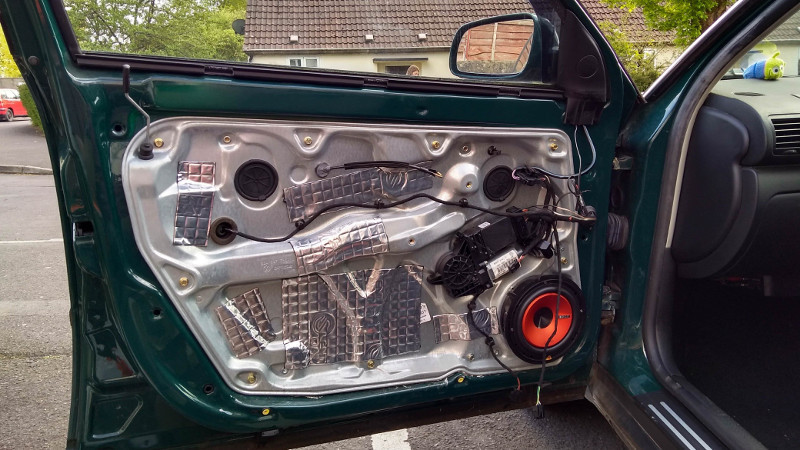There are times when it’s nice to hear the engine roar of a V8 or the whir of a turbocharged engine. However, not all sounds emanating from a vehicle are as amusing, so manufacturers have created methods to muffle them in a number of newer vehicles.
The method, known as active noise control or active noise cancellation, employs the production of sound frequencies that “block out” environmental sounds like wind, tire, and road noises.
How Does Active Noise Control Work In a Car?
Active noise control is meant to do just that: reduce cabin noise by producing soothing sounds from within the vehicle. Multiple microphones located inside the vehicle’s interior and other sensors work together to determine the source of disturbances including wind, tire vibration, and powertrain noise. These signals are then used to generate an inverse frequency to the sounds being produced within the cabin.

The frequency is broadcast via the audio and continues to function even when the sound is turned off or muted, making the interior of the vehicle quieter. This feature has the potential to improve ride quality by reducing noise and vibrations.
This sound, which the audio system produces and which is known as “destructive interference,” is barely audible but is adequate to cancel out the noise for the passenger’s hearing. The sound waves are combined into one nearly flat line, which is 180 degrees from the high and low waves that would otherwise reach the passengers’ ears from the engine or the road.
However, ANC is sometimes ineffective because road noise can be unpredictable and heard by the passengers in a matter of milliseconds.
Active Noise Control Enhances the Driving Experience
When the Drive Mode is set to Sport, active noise control also activates engine sound enhancement, which takes data from the accelerator pedal and engine sensors to generate a synthetic engine sound that is played through the car’s stereo system. This feature is offered on a number of Ford trucks as well as the new Toyota Tundra, according to pickuptrucktalk.com.
When in Sport Mode, the engine sound enhancement system and active noise control collaborate to drown out exterior noise while amplifying the engine’s deeper, more athletic exhaust tone. As the vehicle’s speed and engine RPM go up, the engine gets louder and it feels like the car is going faster.

Is Active noise control safe to use?
The use of active noise cancellation is absolutely safe because it does not obstruct your ability to hear important environmental cues like sirens or car horns. It won’t silence the joyful sounds, either.
Are there alternatives to Active Noise control?
Sound Insulation
Physical materials used in vehicles to reduce the impact of outside noise include sound deadening and insulation. Although the materials used to create this barrier between the cabin and the rest of the vehicle might vary widely, it is common for manufacturers to include some sort of soundproofing in this space.
Some vehicles have a double-paned glass or even thicker glass installed, which significantly reduces exterior noise. Active noise cancellation uses other sounds to cancel out the unwanted ones. Physical sound insulation, on the other hand, just makes everything quieter.

Hyundai-designed Active Noise Control for Road Noise
Road Noise Active Noise Control (RANC) is the latest innovation from Hyundai. Because RANC works even when the unwanted noise is consistent and predictable, such as when an engine is running, the company claims it can make a car even quieter than standard Active Noise Control.
In addition to the microphones and sensors used for Active Noise Control, the RANC system employs an acceleration sensor to compute road vibration and transmit it to a control computer for analysis.
It is possible that RANC could lessen the requirement for heavy soundproofing materials in vehicles, hence reducing their overall weight. Since there is no engine noise to cover up, this method also seems like it would work well in electric cars, where noise from the road and wind can be much louder.
What is the downside of Active Noise Control?
Noise levels produced by Active Noise Control systems may be too high for some people’s tastes. If you opt to install a premium aftermarket audio system in your vehicle, the reversed sounds produced by the Active Noise Control feature could be exacerbated.

There are two ways to disable the active noise cancellation system in your car. First, look for technical support from a dealership or a sound system installer. They can tune the system and turn off this feature in your car.
The other option is to DIY, starting with a search on the internet to see how it can be done on your specific vehicle. You will hear more road, tire, wind, and engine noise inside your car when your active noise cancellation is turned off. However, if you’re not skilled with tools and a multimeter, this DIY method might not be the best choice.


Can I install after market unit for active noise cancellation for my car
How to retrofit active noise cancellation in a car